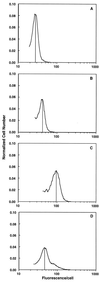Mitochondrial decay in hepatocytes from old rats: membrane potential declines, heterogeneity and oxidants increase
- PMID: 9096346
- PMCID: PMC20322
- DOI: 10.1073/pnas.94.7.3064
Mitochondrial decay in hepatocytes from old rats: membrane potential declines, heterogeneity and oxidants increase
Abstract
Mitochondrial function during aging was assessed in isolated rat hepatocytes to avoid the problem of differential lysis when old, fragile mitochondria are isolated. Rhodamine 123, a fluorescent dye that accumulates in mitochondria on the basis of their membrane potential, was used as a probe to determine whether this key function is affected by aging. A marked fluorescent heterogeneity was observed in hepatocytes from old (20-28 months) but not young (3-5 months) rats, suggesting age-associated alterations in mitochondrial membrane potential, the driving force for ATP synthesis. Three distinct cell subpopulations were separated by centrifugal elutriation; each exhibited a unique rhodamine 123 fluorescence pattern, with the largest population from old rats having significantly lower fluorescence than that seen in young rats. This apparent age-associated alteration in mitochondrial membrane potential was confirmed by measurements with radioactive tetraphenylphosphonium bromide. Cells from young rats had a calculated membrane potential of -154 mV, in contrast to that of the three subpopulations from old rats of -70 mV (the largest population), -93 mV, and -154 mV. Production of oxidants was examined using 2',7'dichlorofluorescin, a dye that forms a fluorescent product upon oxidation. The largest cell subpopulation and a minor one from old animals produced significantly more oxidants than cells from young rats. To investigate the molecular cause(s) for the heterogeneity, we determined the levels of an age-associated mtDNA deletion. No significant differences were seen in the three subpopulations, indicating that the mitochondrial decay is due to other mutations, epigenetic changes, or both.
Figures




References
Publication types
MeSH terms
Substances
Grants and funding
LinkOut - more resources
Full Text Sources
Other Literature Sources

